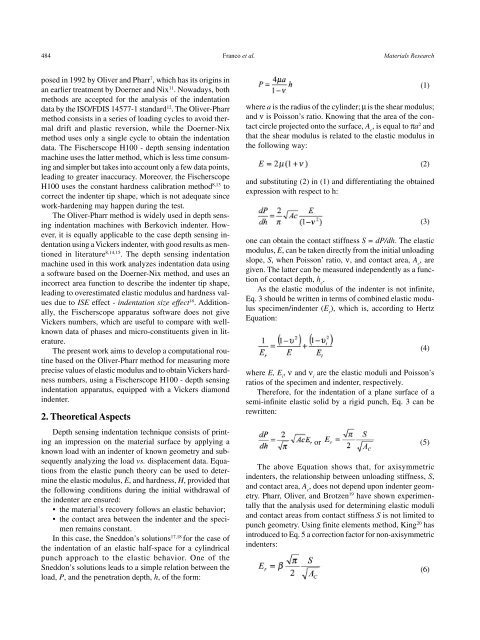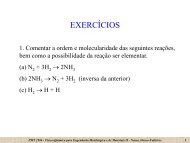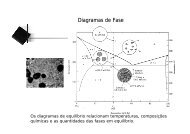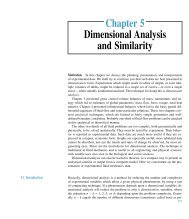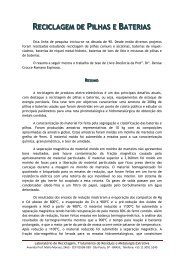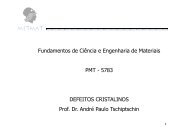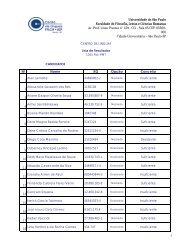The Use of a Vickers Indenter in Depth Sensing Indentation for ...
The Use of a Vickers Indenter in Depth Sensing Indentation for ...
The Use of a Vickers Indenter in Depth Sensing Indentation for ...
Create successful ePaper yourself
Turn your PDF publications into a flip-book with our unique Google optimized e-Paper software.
484 Franco et al. Materials Research<br />
posed <strong>in</strong> 1992 by Oliver and Pharr 7 , which has its orig<strong>in</strong>s <strong>in</strong><br />
an earlier treatment by Doerner and Nix 11 . Nowadays, both<br />
methods are accepted <strong>for</strong> the analysis <strong>of</strong> the <strong>in</strong>dentation<br />
data by the ISO/FDIS 14577-1 standard 12 . <strong>The</strong> Oliver-Pharr<br />
method consists <strong>in</strong> a series <strong>of</strong> load<strong>in</strong>g cycles to avoid thermal<br />
drift and plastic reversion, while the Doerner-Nix<br />
method uses only a s<strong>in</strong>gle cycle to obta<strong>in</strong> the <strong>in</strong>dentation<br />
data. <strong>The</strong> Fischerscope H100 - depth sens<strong>in</strong>g <strong>in</strong>dentation<br />
mach<strong>in</strong>e uses the latter method, which is less time consum<strong>in</strong>g<br />
and simpler but takes <strong>in</strong>to account only a few data po<strong>in</strong>ts,<br />
lead<strong>in</strong>g to greater <strong>in</strong>accuracy. Moreover, the Fischerscope<br />
H100 uses the constant hardness calibration method 8,13 to<br />
correct the <strong>in</strong>denter tip shape, which is not adequate s<strong>in</strong>ce<br />
work-harden<strong>in</strong>g may happen dur<strong>in</strong>g the test.<br />
<strong>The</strong> Oliver-Pharr method is widely used <strong>in</strong> depth sens<strong>in</strong>g<br />
<strong>in</strong>dentation mach<strong>in</strong>es with Berkovich <strong>in</strong>denter. However,<br />
it is equally applicable to the case depth sens<strong>in</strong>g <strong>in</strong>dentation<br />
us<strong>in</strong>g a <strong>Vickers</strong> <strong>in</strong>denter, with good results as mentioned<br />
<strong>in</strong> literature 8,14,15 . <strong>The</strong> depth sens<strong>in</strong>g <strong>in</strong>dentation<br />
mach<strong>in</strong>e used <strong>in</strong> this work analyzes <strong>in</strong>dentation data us<strong>in</strong>g<br />
a s<strong>of</strong>tware based on the Doerner-Nix method, and uses an<br />
<strong>in</strong>correct area function to describe the <strong>in</strong>denter tip shape,<br />
lead<strong>in</strong>g to overestimated elastic modulus and hardness values<br />
due to ISE effect - <strong>in</strong>dentation size effect 16 . Additionally,<br />
the Fischerscope apparatus s<strong>of</strong>tware does not give<br />
<strong>Vickers</strong> numbers, which are useful to compare with wellknown<br />
data <strong>of</strong> phases and micro-constituents given <strong>in</strong> literature.<br />
<strong>The</strong> present work aims to develop a computational rout<strong>in</strong>e<br />
based on the Oliver-Pharr method <strong>for</strong> measur<strong>in</strong>g more<br />
precise values <strong>of</strong> elastic modulus and to obta<strong>in</strong> <strong>Vickers</strong> hardness<br />
numbers, us<strong>in</strong>g a Fischerscope H100 - depth sens<strong>in</strong>g<br />
<strong>in</strong>dentation apparatus, equipped with a <strong>Vickers</strong> diamond<br />
<strong>in</strong>denter.<br />
2. <strong>The</strong>oretical Aspects<br />
<strong>Depth</strong> sens<strong>in</strong>g <strong>in</strong>dentation technique consists <strong>of</strong> pr<strong>in</strong>t<strong>in</strong>g<br />
an impression on the material surface by apply<strong>in</strong>g a<br />
known load with an <strong>in</strong>denter <strong>of</strong> known geometry and subsequently<br />
analyz<strong>in</strong>g the load vs. displacement data. Equations<br />
from the elastic punch theory can be used to determ<strong>in</strong>e<br />
the elastic modulus, E, and hardness, H, provided that<br />
the follow<strong>in</strong>g conditions dur<strong>in</strong>g the <strong>in</strong>itial withdrawal <strong>of</strong><br />
the <strong>in</strong>denter are ensured:<br />
• the material’s recovery follows an elastic behavior;<br />
• the contact area between the <strong>in</strong>denter and the specimen<br />
rema<strong>in</strong>s constant.<br />
In this case, the Sneddon’s solutions 17,18 <strong>for</strong> the case <strong>of</strong><br />
the <strong>in</strong>dentation <strong>of</strong> an elastic half-space <strong>for</strong> a cyl<strong>in</strong>drical<br />
punch approach to the elastic behavior. One <strong>of</strong> the<br />
Sneddon’s solutions leads to a simple relation between the<br />
load, P, and the penetration depth, h, <strong>of</strong> the <strong>for</strong>m:<br />
where a is the radius <strong>of</strong> the cyl<strong>in</strong>der; µ is the shear modulus;<br />
and ν is Poisson’s ratio. Know<strong>in</strong>g that the area <strong>of</strong> the contact<br />
circle projected onto the surface, A c<br />
, is equal to πa 2 and<br />
that the shear modulus is related to the elastic modulus <strong>in</strong><br />
the follow<strong>in</strong>g way:<br />
and substitut<strong>in</strong>g (2) <strong>in</strong> (1) and differentiat<strong>in</strong>g the obta<strong>in</strong>ed<br />
expression with respect to h:<br />
one can obta<strong>in</strong> the contact stiffness S = dP/dh. <strong>The</strong> elastic<br />
modulus, E, can be taken directly from the <strong>in</strong>itial unload<strong>in</strong>g<br />
slope, S, when Poisson’ ratio, ν, and contact area, A c<br />
, are<br />
given. <strong>The</strong> latter can be measured <strong>in</strong>dependently as a function<br />
<strong>of</strong> contact depth, h c<br />
.<br />
As the elastic modulus <strong>of</strong> the <strong>in</strong>denter is not <strong>in</strong>f<strong>in</strong>ite,<br />
Eq. 3 should be written <strong>in</strong> terms <strong>of</strong> comb<strong>in</strong>ed elastic modulus<br />
specimen/<strong>in</strong>denter (E r<br />
), which is, accord<strong>in</strong>g to Hertz<br />
Equation:<br />
where E, E i<br />
, ν and ν i<br />
are the elastic moduli and Poisson’s<br />
ratios <strong>of</strong> the specimen and <strong>in</strong>denter, respectively.<br />
<strong>The</strong>re<strong>for</strong>e, <strong>for</strong> the <strong>in</strong>dentation <strong>of</strong> a plane surface <strong>of</strong> a<br />
semi-<strong>in</strong>f<strong>in</strong>ite elastic solid by a rigid punch, Eq. 3 can be<br />
rewritten:<br />
(1)<br />
(2)<br />
(3)<br />
(4)<br />
or (5)<br />
<strong>The</strong> above Equation shows that, <strong>for</strong> axisymmetric<br />
<strong>in</strong>denters, the relationship between unload<strong>in</strong>g stiffness, S,<br />
and contact area, A c<br />
, does not depend upon <strong>in</strong>denter geometry.<br />
Pharr, Oliver, and Brotzen 19 have shown experimentally<br />
that the analysis used <strong>for</strong> determ<strong>in</strong><strong>in</strong>g elastic moduli<br />
and contact areas from contact stiffness S is not limited to<br />
punch geometry. Us<strong>in</strong>g f<strong>in</strong>ite elements method, K<strong>in</strong>g 20 has<br />
<strong>in</strong>troduced to Eq. 5 a correction factor <strong>for</strong> non-axisymmetric<br />
<strong>in</strong>denters:<br />
(6)


